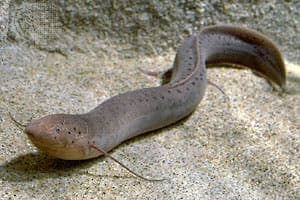 |
| a coelacanth |
The coelacanth, or 'living fossil' as it is nick-named, was long believed to be extinct. It wasn't until 1938 that the species was recognized in a fish market in South Africa.
The coelacanth and the lungfish, a fish breathes air through lungs, are both fish that experts believe might be related to the fish species that first developed fins into feet.
The question is: Which is closer related?
The decoding of the lungfish's genome uncovered that the lungfish is, in fact, the closer related.
However, the genome of the coelacanth might hold more answers in the process of turning fins into feet than the lungfish genome can. The genome of a coelacanth, at 2.8 billion units of DNA, is about the same size as a human's and is decodable, while the genome of a lungfish is 100 billion units of DNA and is undecodable with the technology available today.
One great discovery in the coelacanth genome is a gene that encourages limb creation within the embryo.
Multiple teams are still studying the genome and are hoping to make many more discoveries on it to shed more light on the question: How did fins turn into feet?
 |
| a lungfish |
The coelacanth and the lungfish, a fish breathes air through lungs, are both fish that experts believe might be related to the fish species that first developed fins into feet.
The question is: Which is closer related?
The decoding of the lungfish's genome uncovered that the lungfish is, in fact, the closer related.
However, the genome of the coelacanth might hold more answers in the process of turning fins into feet than the lungfish genome can. The genome of a coelacanth, at 2.8 billion units of DNA, is about the same size as a human's and is decodable, while the genome of a lungfish is 100 billion units of DNA and is undecodable with the technology available today.
One great discovery in the coelacanth genome is a gene that encourages limb creation within the embryo.
Multiple teams are still studying the genome and are hoping to make many more discoveries on it to shed more light on the question: How did fins turn into feet?
 |
| a coelacanth |
NOS:
1. Science is collaborative: Many different teams of people are working on this project.
2. Science is based on evidence: All conclusions and discoveries were made after many studies, experiments, and data gatherings.
4. Role of creditably: The people working on this are/are being checked by doctors and experts.
10. Role of motivation and curiosity: It is a very interesting and important question, how did evolution unfold on a genetic level?
THIS ARTICLE: Fish's DNA May Explain How Fins Turned to Feet
OTHER ARTICLES RELATED TO THIS SUBJECT:
This is a really cool article, especially since it's so relevant to what we're doing in class right now. The choleanth and the lungfish are good examples of missing links that have been found. They're kind of like intermediate fossils. I also found all the links that you provided to be very helpful. So good job all around.
ReplyDelete